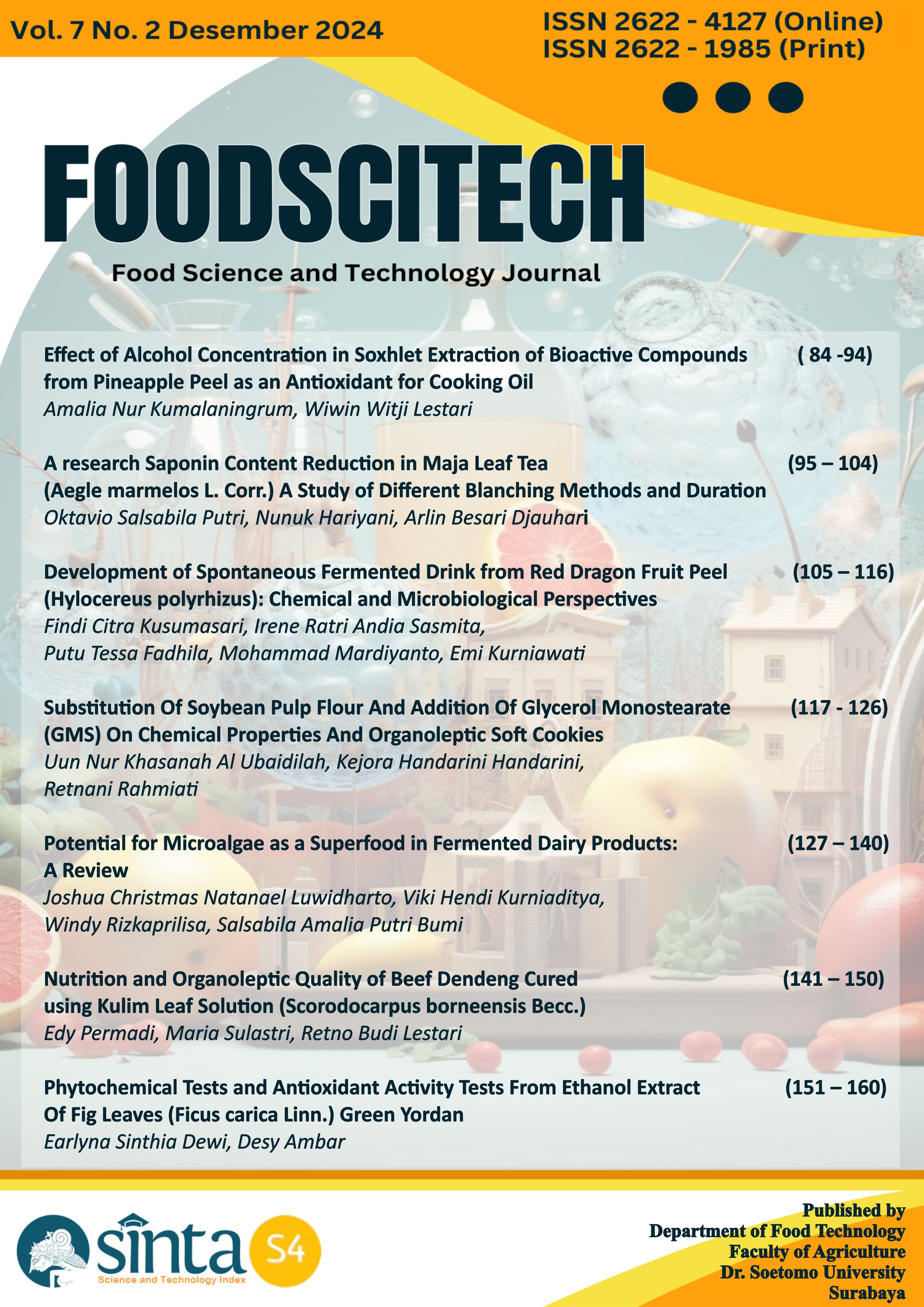Main Article Content
Abstract
The fig plant (Ficus carica L.) is one of the Moraceae family, which usually grows in countries with tropical
and subtropical regions whose leaves have the potential as traditional medicine and also as an antioxidant.
The purpose of this study was to identify the phytochemical content and antioxidant compounds from the
ethanol extract of fig leaves of the Green Jordan variety. Active compounds were extracted by the
maceration method using ethanol solvent with concentrations of 50%, 60%, 70%, and 96%. Phytochemical
tests include testing for alkaloids, flavonoids, saponins, and tannins. The antioxidant activity test was carried
out using the DPPH method (2,2-diphenyl-1-picrylhydrazyl). The antioxidant activity test was carried out
using the DPPH method (2,2-diphenyl-1-picrylhydrazyl). The results of the phytochemical test showed that
the secondary metabolites contained in the ethanol extract with various concentrations of Fig leaves include
alkaloids, flavonoids, saponins, and tannins In addition, Fig leaves extract with 96% ethanol solvent has a
very strong antioxidant potential of 96.0%.
Keywords
Article Details

This work is licensed under a Creative Commons Attribution-NonCommercial-ShareAlike 4.0 International License.

This work is licensed under a Creative Commons Attribution-ShareAlike 4.0 International License.
References
- Azizah, B., & Salamah, N. (2013). STANDARISASI PARAMETER NON SPESIFIK DAN PERBANDINGAN KADAR KURKUMIN EKSTRAK ETANOL DAN EKSTRAK TERPURIFIKASI RIMPANG KUNYIT. Pharmaciana, 3(1). https://doi.org/10.12928/pharmaciana.v3i1.416
- Dewi, E. S., Hakim, A., & Savalas, L. R. T. (2018). Pengaruh Pemberian Ekstrak Likopen Buah Tomat (Lycopersicium esculentum) Terhadap Pertumbuhan Staphylococcus epidermidis. Jurnal Penelitian Dan Kajian Ilmiah Kesehatan, 4(2), 123–127.
- Dey, P., Kundu, A., Kumar, A., Gupta, M., Lee, B. M., Bhakta, T., … Kim, H. S. (2020). Analysis of alkaloids (indole alkaloids, isoquinoline alkaloids, tropane alkaloids). In Recent Advances in Natural Products Analysis (pp. 505–567). https://doi.org/10.1016/B978-0-12-816455-6.00015-9
- Dhianawaty, D., & Ruslin. (2015). Total polyphenol content and antioxidant activity of methanol extract Imperata cylindrica (L) Beauv Roots. Majalah Kedokteran Bandung, 47(1), 60–64.
- Dykes, L. (2019). Tannin analysis in sorghum grains. In Methods in Molecular Biology (Vol. 1931, pp. 109–120). https://doi.org/10.1007/978-1-4939-9039-9_8
- GOUD, N. S., & PRASAD, G. (2020). ANTIOXIDANT, ANTIMICROBIAL ACTIVITY AND TOTAL PHENOL AND FLAVONOIDS ANALYSIS OF SAMBUCUS NIGRA (ELDERBERRY). International Journal of Current Pharmaceutical Research, 35–37. https://doi.org/10.22159/ijcpr.2020v12i1.36829
- Heliawati, L. (2018). Kimia Bahan Organik Alam. Pascasarjana UNPAK, 1–142.
- Hidayah, T. (2013). Uji Stabilitas Pigmen dan Antioksidan Hasil Ekstraksi Zat Warna Alami dari Kulit Buah Naga (Hylocereus undatus). In Fakultas Matematika Dan Ilmu Pengetahuan Alam Universitas Negeri Semarang (Vol. 29).
- Jaramillo-Carmona, S., Rodriguez-Arcos, R., Jiménez-Araujo, A., López, S., Gil, J., Moreno, R., & Guillén-Bejarano, R. (2017). Saponin Profile of Wild Asparagus Species. Journal of Food Science, 82(3), 638–646. https://doi.org/10.1111/1750-3841.13628
- Marliana, S. D., Suryanti, V., & Suyono. (2005). Skrining Fitokimia dan Analisis Kromatografi Lapis Tipis Komponen Kimia Buah Labu Siam ( Sechium edule Jacq . Swartz .) dalam Ekstrak Etanol. Biofarmasi, 3(1), 26–31.
- Nafi’ah, R., & Nurulhuda, A. H. (2020). Uji Aktivitas Krim Ekstrak Daun Tin (Ficus carica Linn.) sebagai Antioksidan. Praeparandi, 4(1). Retrieved from http://jurnal.stfypibcirebon.ac.id/index.php/ojs/article/view/80
- Plaza, C. M., De Torres, L. E. D., Lücking, R. K., Vizcaya, M., & Medina, G. E. (2014). Antioxidant activity, total phenols and flavonoids of lichens from venezuelan andes. Journal of Pharmacy and Pharmacognosy Research, 2(5), 138–147.
- Prayoga, H. N., & Rahmawati, N. (2019). Isolasi dan Uji Aktivitas Antioksidan Senyawa Metabolit Sekinder dari Fraksi n-Butanol Daun Tin (Ficus carica L.) Varietas Brown Turkey. Jurnal Penelitian Farmasi Indonesia, 8(1), 24–31. https://doi.org/10.51887/jpfi.v8i1.625
- S, R. H. (1994). J. GRAYER and JEFFREY B. HARBORNE Department of Botany, University of Reading, Whiteknights, Reading RG6 2AS, U.K. Phytochemestry, 37(1), 19–42.
- Sirisha, N., Sreenivasulu, M., Sangeeta, K., & Madhusudhana Chetty, C. (2010). Antioxidant properties of Ficus Species - a review. International Journal of PharmTech Research, Vol. 2, pp. 2174–2182.
- Tawfeek, N., Mahmoud, M. F., Hamdan, D. I., Sobeh, M., Farrag, N., Wink, M., & El-Shazly, A. M. (2021). Phytochemistry, Pharmacology and Medicinal Uses of Plants of the Genus Salix: An Updated Review. Frontiers in Pharmacology, Vol. 12. https://doi.org/10.3389/fphar.2021.593856
- Verma, I., Gupta, R. K., Rajinder, C., & Gupta, K. (2015). Estimation of phytochemical, nutritional, antioxidant and antibacterial activity of dried fruit of sacred figs (Ficus religiosa) and formulation of value added product (Hard Candy). Journal of Pharmacognosy and Phytochemistry JPP, 4(3), 257–267. Retrieved from http://www.phytojournal.com/archives/2015/vol4issue3/PartD/4-3-57.pdf
